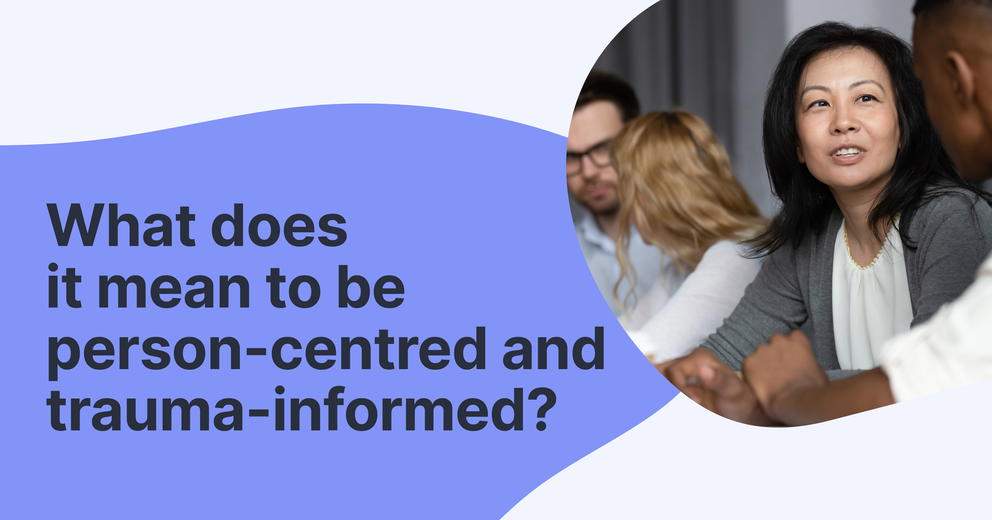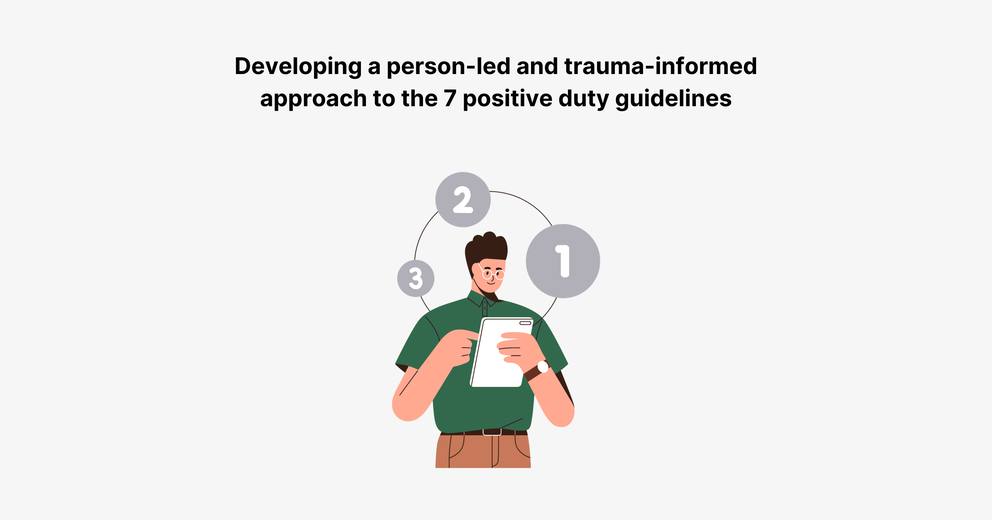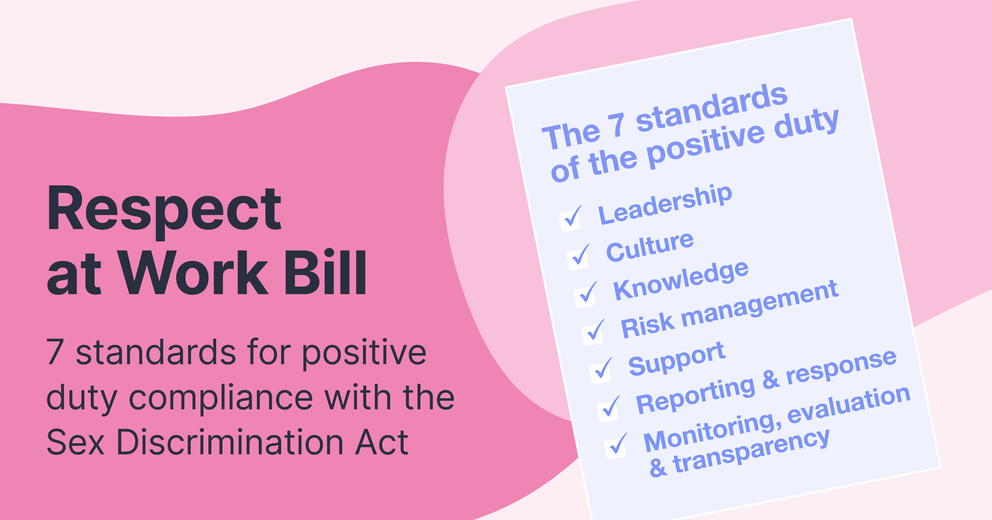What does it mean to be person-centred and trauma-informed? Exploring the AHRC's guiding principles

If you're familiar with the Respect at Work Bill, you've probably come across the terms "trauma-informed" and "person-centred". These terms describe the approach to supporting individuals impacted by unlawful conduct. As we work on improving compliance and safety in our workplaces, we must understand these terms and put into practice the concepts learned. This knowledge ensures the respect and care that people deserve when dealing with sensitive incidents.
Legislative reforms
In August 2023, the Australian Human Rights Commission (AHRC) released clear guidelines for compliance with the updated Sex Discrimination Act 1984 (Cth). These guidelines detail seven standards all Australian workplaces must follow to ensure they align with the legislative amendments. The aim is straightforward: eliminate all forms of discrimination and harassment on the ground of sex in the workplace.
Businesses and organisations in Australia understand that hostile work environments can hinder their talent acquisition and retention, decrease efficiency, and expose them to substantial legal and reputational challenges. Such an environment can deter potential customers and investors, impacting their reputation and financial health.
Understanding the positive duty requirements
All employers are responsible for fostering a safe working environment, regardless of an individual's gender, sexual preference, race, disability or protected status. Positive duty was a key amendment introduced in the Respect at Work legislation that mandates employers to be proactive in eliminating workplace sexual harassment and sex-based discrimination.
Businesses, universities and organisations can no longer be complacent in their duties towards protecting individuals. They can no longer simply react to reports of unlawful conduct. The law now states that they must take all reasonable and proportionate measures to eliminate unlawful conduct from the workplace.
The four guiding principles
Meeting positive duty compliance is one thing. How workplaces interpret, understand and guide the policies and training around their compliance is a different challenge.
The quality of understanding, support and care we provide to one another in the workplace can make a difference to the mental health of our colleagues and members. The mental wellbeing of employees is particularly foundational to a safe and positive working environment. Human resources and company leaders will use these principles to improve employee retention and satisfaction. As such, the AHRC recommends four guiding principles for the effective implementation of the positive duty standards:
Consultation
Engage in meaningful dialogue with workers. Understanding their needs and concerns. Discuss workplace risks and strategies for eliminating unlawful conduct. Assess what current policies, wellness or mental health care services you provide for employees and ask whether these benefits meet the needs of workers. And finally, as you implement policy and steps toward your positive duty, communicate and involve employees.
Gender equality
Through policies, leadership and practice, you must commit to ensuring equal rights, rewards, opportunities, and resources for individuals of all genders. Leadership should reinforce the collective goal of achieving comprehensive gender equality. This principle does not mean a cynical "box ticking" of compliance. It means a serious commitment to cultural change through diversity in the recruitment process, reviewing your organisation's gender pay gap, and fostering inclusion strategies.
Intersectionality
When guiding policy and practice, the multifaceted aspects of an individual's identity should be recognised. Intersectionality refers to the interconnected nature of economic class, race, culture, religion, age, disabilities, gender, and lived experiences. These aspects interact and affect each other, compounding both privileges and oppressions. These differences shape the individual's response to trauma, comfort levels in reporting incidents and, ultimately, the dynamics of a workplace.
Trauma-informed and person-centred care
A trauma-informed and person-centred approach puts individuals' needs, values and preferences at its core. It prioritises an individual's safety, choices and empowerment and acknowledges the profound impact of trauma in the response to unlawful conduct. This guiding principle is arguably the most complex, as it determines the quality and effectiveness of trauma-informed care. We will further analyse this principle, showing how to apply these approaches to the AHRC's positive duty guidelines.

What does being person-centred mean?
A person-centred approach focuses on the individual's unique experiences, needs, and preferences rather than solely relying on established systems or practices. This approach diverges from traditional service or system-based approaches, which have historically been the norm, especially in the context of addressing issues such as sexual harassment.
Key aspects of a person-centred approach:
- Empowerment: The affected individual plays a pivotal role in deciding how to report an issue and is included in decision-making about how to address it. While their wishes and interests are paramount, it doesn't necessarily mean they singularly determine an organisation's response. The organisation must balance this with their duty of care to others.
- Respect for timing: Recognising that individuals may need time to process incidents and should feel free to share their experiences when they're ready. Imposing stringent time limitations on reporting can dissuade individuals from coming forward.
- Tailored responses over blanket solutions: Traditional methods might lean towards broad solutions designed to fit organisational structures. In contrast, person-centred care seeks solutions best suited for the individual affected, considering their specific context and needs.
- Prioritising wellbeing: An approach that emphasises the wellbeing of individuals fosters greater trust and engagement. It also facilitates the recovery process for all parties involved, leading to more victims coming forward and improved chances for a satisfactory resolution.
- Distinguishing between system and individual: To illustrate the difference:
- Engage in conversations with the individual rather than discussing them without their involvement.
- Prioritise listening over merely directing or instructing.
- Collaborate in planning with the individual instead of imposing plans upon them.
- Understand and respect their unique context instead of applying broad organisational interpretations.
- Respect every individual's position in the organisation, disregarding hierarchical differences.
What is trauma-informed care?
Trauma refers to an individual's emotional, psychological, and sometimes physical response to events or situations that are deeply distressing or disturbing. These events can vary from personal experiences like domestic violence, accidents, or personal losses to work-related incidents such as bullying, harassment, or serious misconduct. It's pivotal to recognise that while many individuals may encounter distressing events, not all will develop trauma. The development and manifestation of trauma are influenced by an individual's resilience, previous experiences, support system, and coping mechanisms.
Given the estimates that a significant proportion of the population experiences trauma, with its potential long-lasting and profound impacts, organisations must adopt a trauma-informed approach. This approach is characterised by:
- Traumatic experiences can be overwhelming. While many who experience trauma share specific reactions, every individual and their experience is unique.
- Trauma can affect memory. The brain's response during traumatic events may affect how those events are recorded and recalled, making recounting specific details challenging.
- Cultural context matters. The individual's identity, which includes aspects like age, ethnic background, sex, disability, migration status, and more, influences how they perceive and recover from traumatic events.
- Respect is key. Being trauma-informed means approaching every individual with the utmost respect for their unique experiences, and understanding that their cultural and personal backgrounds play a role in how they deal with trauma.
When it comes to practical application, especially in sensitive situations like interviews, a trauma-informed approach involves:
- Transparency: Clearly explaining roles, processes, and the importance of confidentiality.
- Prioritising control and choice: Letting the individual have control over aspects like the interview location, ensuring they know they can pause or stop the process anytime.
- Active listening: Minimising interruptions, allowing the individual to lead the conversation, and maintaining a good rapport.
- Neutral language: Using non-directive questions that encourage sharing without challenging the individual's recollection.
- Safety and comfort: Creating a secure and private environment for the discussion, keeping the participant's wellbeing in mind.
Adopting a trauma-informed approach is not just about understanding trauma but integrating that understanding into practices and policies to ensure an empathetic, respectful, and effective response to those who have experienced trauma.

Tackling the 7 positive duty guidelines with a person-led and trauma-informed approach
1. Leadership
Through the lens of trauma-informed and person-centred care, leadership should exemplify genuine empathy and active listening. Leaders must ensure their teams feel valued and understood, especially when disclosing incidents. Practically, this requires leaders to undergo trauma-informed training to ensure competent handling of incidents and be proactive in setting a respectful and safe tone for discussions and reporting.
2. Culture
An organisational culture that embraces trauma-informed and person-led principles fosters inclusivity. Embracing diversity and intersectionality ensures that all workers feel recognised and protected regardless of background. Practical measures include conducting a culture audit, regular diversity, equity, and inclusion training, and promoting open dialogue and mutual respect. Bystander training can ensure that workers feel comfortable acting in the prevention of sexual harassment and violence in the workplace.
Your organisation, whether remote or hybrid, may face challenges like virtual harassment that are less visible. Regular employee check-ins are vital. Use surveys and corporate wellness tools to gauge satisfaction and identify issues early.
3. Knowledge
Knowledge acquisition in this context refers to comprehending the nuanced effects of trauma and how to support affected workers. Recognising the impact of trauma and maintaining confidentiality is paramount. On a practical level, this means continuous staff education on trauma-informed care principles and clear guidelines on maintaining discretion.
4. Risk management
Mitigating potential hazards in the workplace requires understanding and anticipating the needs of those who have experienced trauma. Respecting and supporting the choices and decisions of workers is vital. This may translate into providing flexible work and leave options for those needing time to recover or cope.
5. Support
Support goes beyond addressing the immediate needs; it encompasses long-term mental and emotional well-being. Offering access to mental health services and ensuring a secure and respectful environment for reporting incidents are key. Employers should also provide guidance on available resources, both within and outside the organisation.
6. Reporting and response
Reporting mechanisms must be transparent and accessible. Guaranteeing that reports are treated with utmost seriousness is paramount. Workers should be empowered to speak up without fear of retribution. The policies and channels should include clear channels for escalation, periodic updates, and support resources available throughout the journey. Adopting an anonymous reporting system, such as Elker, can be a practical solution to tackling this standard.
7. Monitoring, evaluation, and transparency
Ongoing assessment ensures that systems in place are effective and address workers' needs adequately. This requires transparency in the reporting process and regular feedback with employees. Surveys, focus groups, and open forums can be utilised to get feedback from workers on the efficacy of implemented measures. Many anonymous reporting tools offer pulse surveys and real-time analytics for the monitoring and early detection of workplace issues.
Conclusion
Understanding and implementing a trauma-informed and person-centred approach is more than just adhering to compliance; it's a commitment to reshaping the workplace culture to one of empathy, respect, and genuine support. In navigating the mandates set by the AHRC, organisations are offered an opportunity not just to avoid penalties but to enrich the lives and well-being of their workforce. The steps taken to understand trauma and prioritise the individual's needs echo far beyond policy documents and become the foundation of a thriving, inclusive, and harmonious work environment.
As Australia continues to evolve in its understanding and approach to workplace harassment and discrimination, it's the duty of every organisation to evolve and foster an environment where every individual feels safe, valued, and heard.


